Onshore Adventures: Island Hopping, Tent Pitching, Turtles, Local Life, and New Friendships
We moored for 14 days in Port Vila because two of our crew members had to leave for a bit. So, Mark and I, being the geniuses we are, decided to ditch the boat and hitchhike around the island for 7 days, trying to pitch our tent somewhere. There are no camping grounds in Vanuatu, and every square meter belongs to someone—even coral reefs and beaches. So, we knew we’d have to ask permission to pitch our tent. But I wasn’t too worried about this because Ni-Vanuatu are just lovely people. I had a feeling finding a little spot for our tiny tent even maybe for a small fee wouldn’t be a problem.
A few days before, we jumped in a Moke and drove around the island, so we thought we’d try to get to some outer islands instead of going around the main one again. We looked up Moso, Nguna, and Pele Island and had a vague idea of how to get there. But again, I wasn’t too worried—I figured we’d find out along the way. All I knew was that we needed to get to Havannah Harbour to catch a boat to Moso.
We first walked to our favourite bakery to stock up on food for the next few days and started hitchhiking from there. Hitchhiking in the city was a bit tricky—every car is a taxi, local bus, or some sort of transport. So, we decided to get as far out of town as possible by local bus for around $2 and start from there. The bus driver told us about another bus stop out of town where we could catch a bus that would take us directly to Havannah Harbour. Once we got to the bus stop, we quickly Googled how much further we had to go, and with another 30 km to our destination, we decided to take the bus for just $7.20 each. This at least got us there just after lunch—who knows how long hitchhiking would’ve taken and it turned out we could’ve taken this bus directly from town.
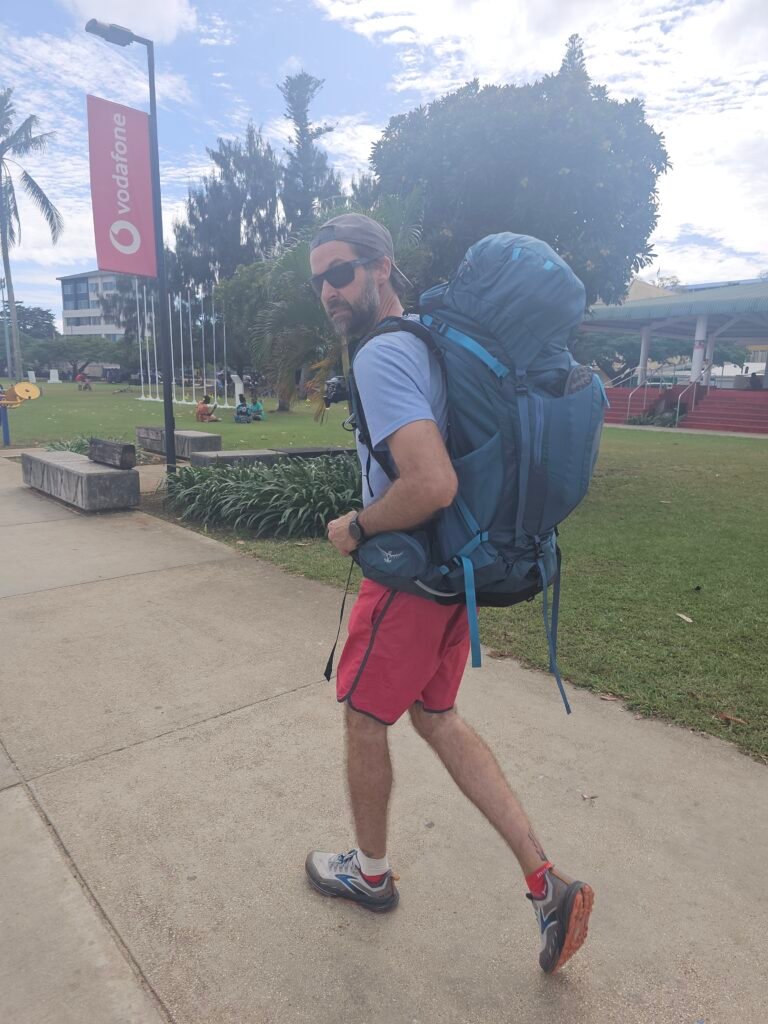
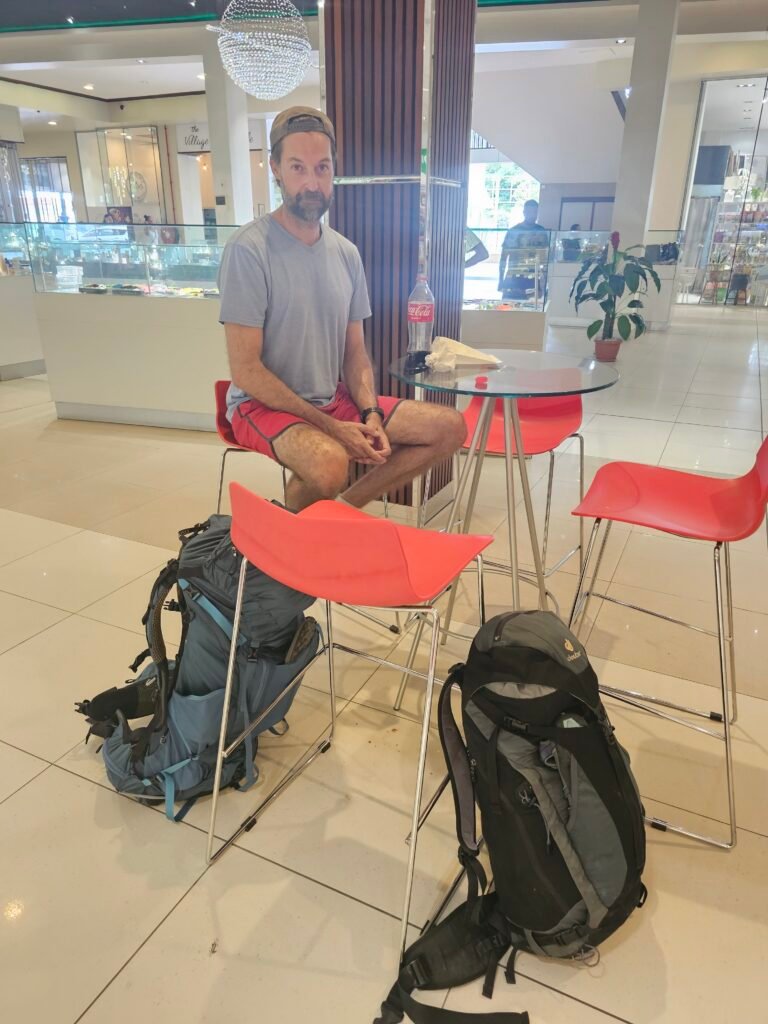
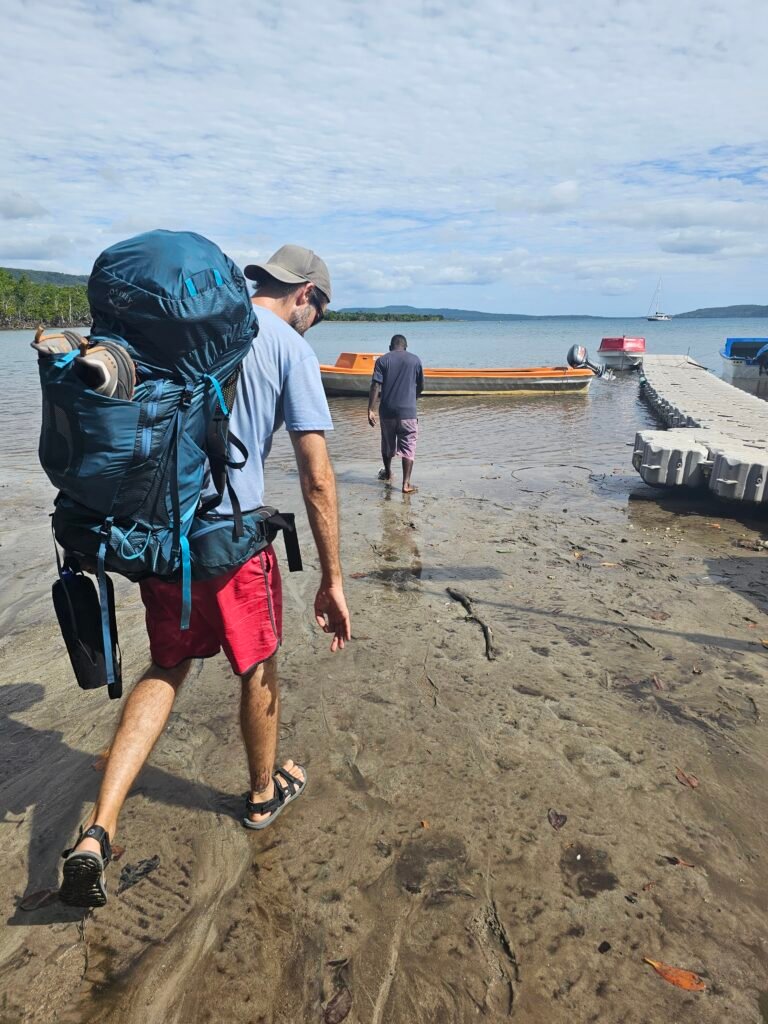
The bus driver was great and double-checked where we wanted to go. Instead of saying Havannah Harbour, I said “the Jetty.” I mean, what were the chances they’d have a pier at Havannah Harbour and another pier called “the Jetty”? Anyway, at one point, everyone was getting off, but the driver told us to stay as he’d bring us to the Jetty. Once we arrived, I asked if this was Havannah Harbour so we could catch a local boat. Turns out we missed the stop for Havannah Harbour, and the Jetty is the pier to Moso Resort. The bus driver assumed we had a booking at Moso Resort. We explained that we weren’t interested in staying at a resort ($700 a night!) and that we had our own tent and food and just wanted to stay in a village with some locals. The driver was very surprised and had to repeat our plans three times until he understood. He was very helpful though and started directly talking to locals at the Jetty, explaining our plans. One local agreed to take us to the island with his boat and bring us to his village called Tasariki.
Rodney was the friendly boat driver who brought us to his brother, who has a property directly on the beach. On the way to the island, Rodney repeated our plans of camping in the village, as he too found it quite odd, just like the bus driver. After a very short journey, we were introduced to Owen and Jenny and first sat down for a little chat. By now, we noticed that everyone seemed very surprised—maybe even suspicious—about our plans. But very quickly, Owen and Rodney went to find a nice spot for us to pitch our tent. Everyone cleaned a little area right next to the beach for us. Since we didn’t have any mattresses, we managed to find an area with high grass, hoping it would give us some cushioning. While setting up our tent, Jenny brought us some fresh papaya. Once set up, we went back to the house to meet the rest of the family. The three boys, Kenneth, Amos, and little Rundron, and the three girls, Susie-Anna, Judy and Daniela, quickly showed us around. Everyone was heading to the garden on the other side of Efate Island, where we had just come from. Once they returned, we helped unload the boat, and Jenny prepared dinner for us all.
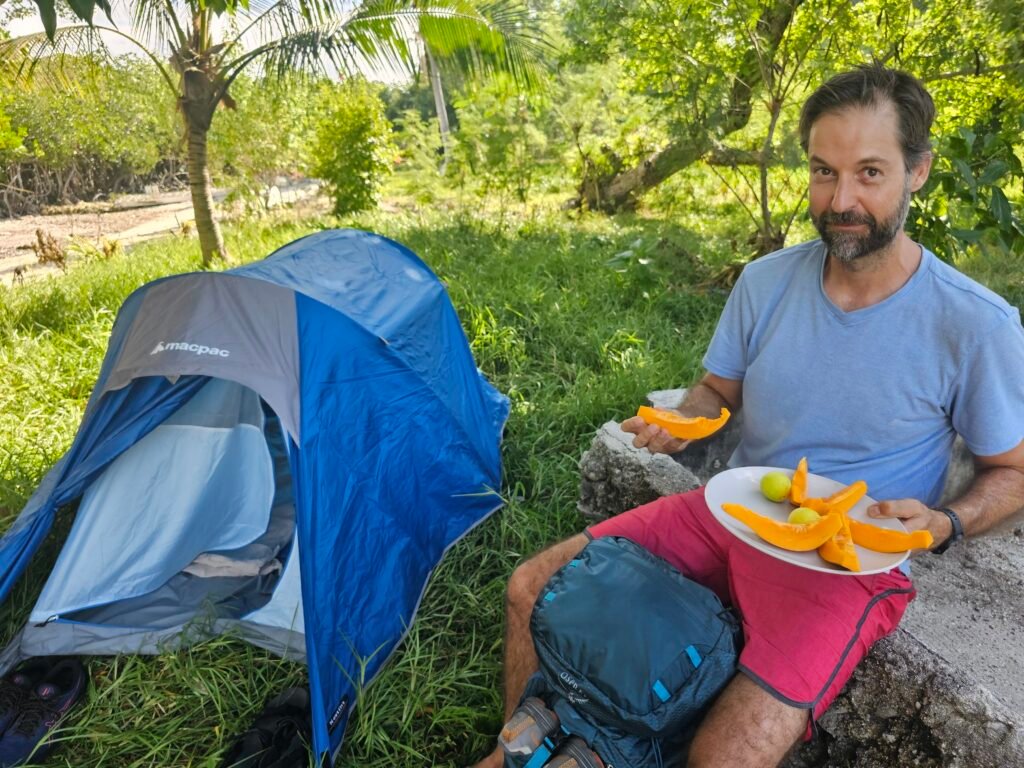
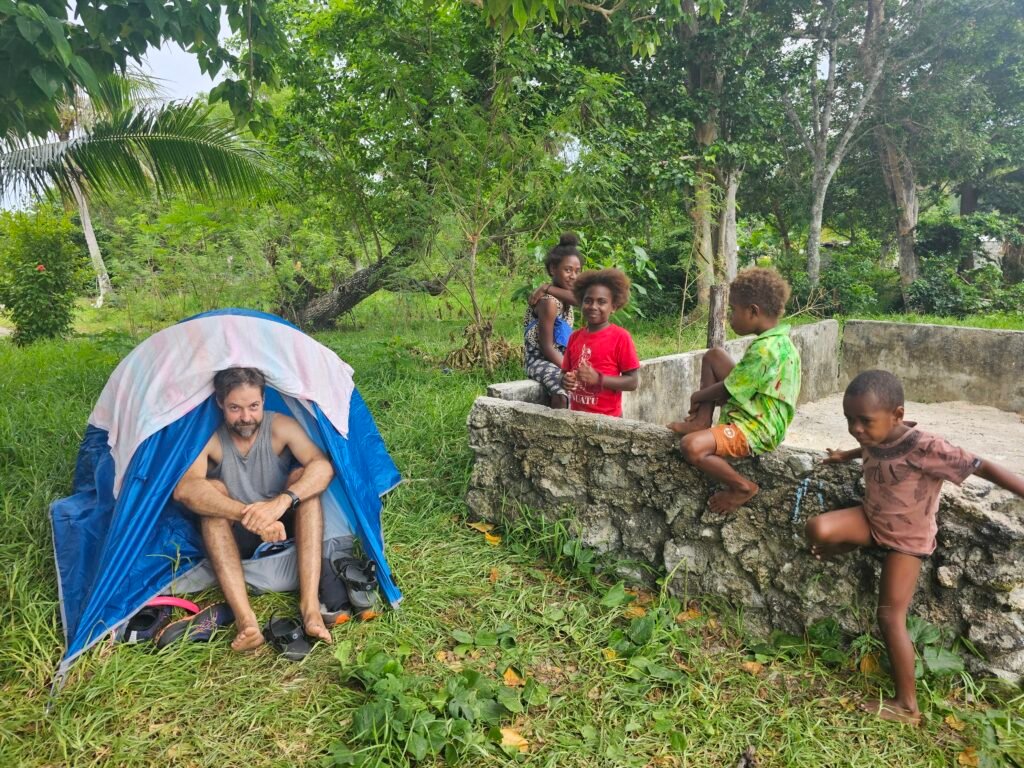
First thing the next morning, Owen took us on a turtle and dugong safari, with Amos standing at the front, pointing out the turtles. Unfortunately, we were a bit late to see the dugongs feeding in the reef early in the morning, but there were plenty of turtles resting around after their feed. Once we got back, Jenny had already organised breakfast—fresh fruit and yummy donuts, which you find here on every corner. We watched everyone making Laplap, a famous local dish involving grated cassava or here called Manioc and coconut, cooked in banana leaves on an underground hot stone oven. Mark had a go at grating coconut by hand when suddenly everyone started screaming. The whole village ran to the beach—a whale was swimming past! One minute later, we found ourselves with a bunch of kids in a boat looking for the whale. Everyone seemed scared of the whale tipping over the boat, so we didn’t get too close, but it was a great experience. By the time we got back, the LapLap was already on the stones, and everyone was getting ready for church. So, we went back to our tent to do some snorkelling to see the giant clams we saw earlier from the boat. They’re so giant they could take off your hand or foot if they snapped shut!

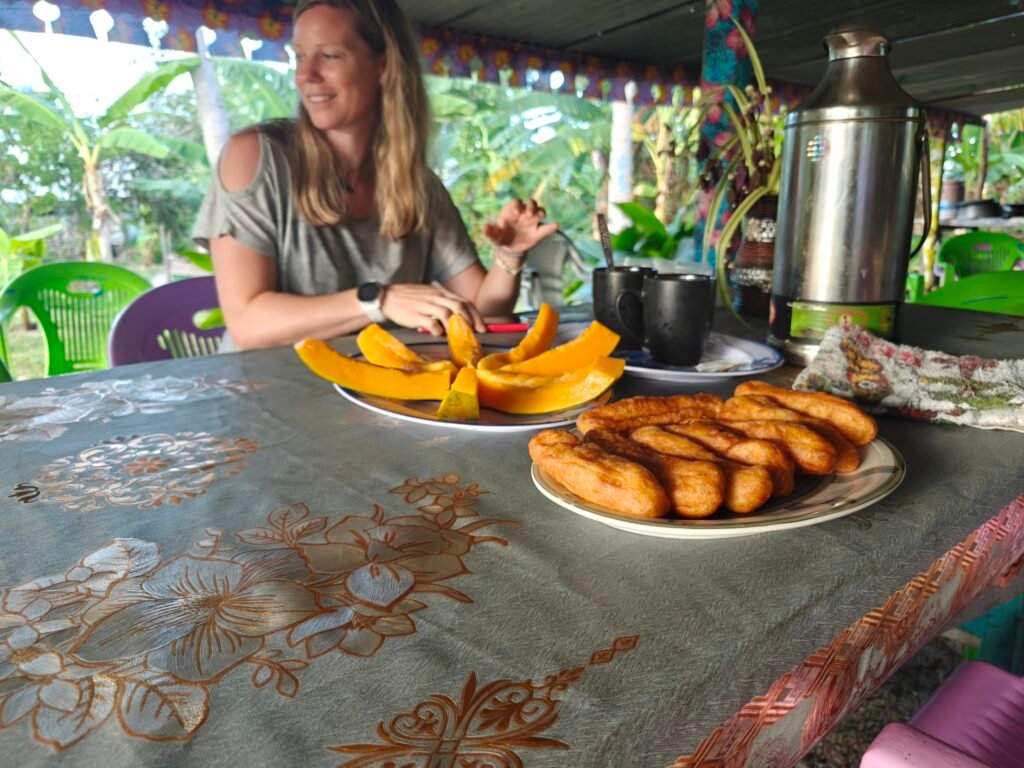
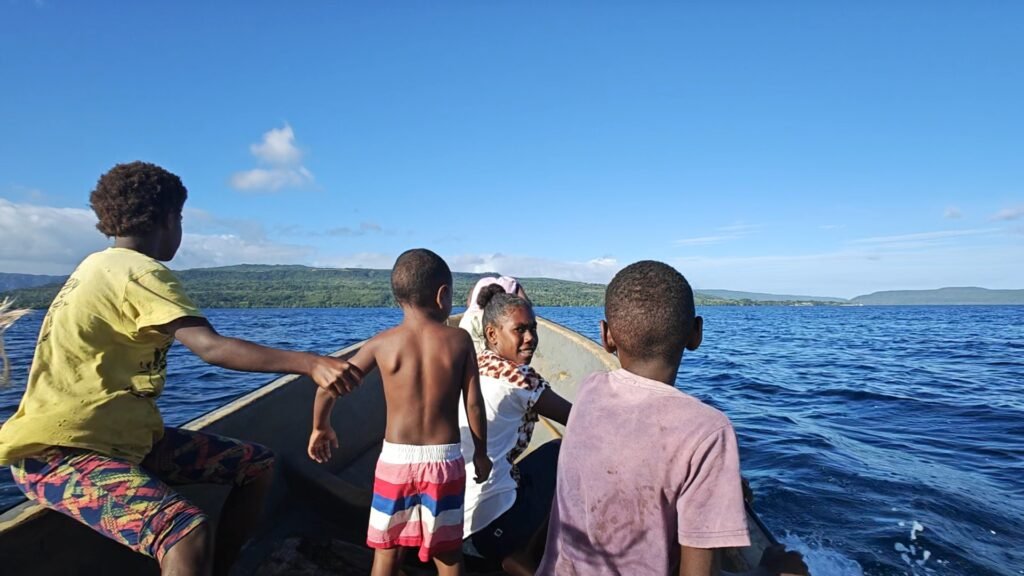
The kids kept coming to the tent so I took out my crossword book and started playing word search with Amos and Kenneth, keeping score. All of a sudden, I had six heads hanging over the book, pushing each other out of the way. They absolutely loved it! When everyone went to church, we attempted to go snorkelling, but with the tide out, we had to walk super far over the reef. After just a few metres, we gave up and turned around—the sound of crushing corals under our feet just felt so wrong. So, we just chilled at the tent until little 4-year-old Rundron came and told us lunch was ready. All the kids speak and understand English since most school subjects are taught in English, but most young people are too shy to speak it. But not little Rundron—he wasn’t shy at all and would speak up for all the other kids. He spoke English really well despite being the youngest and not even in school yet.
Once we got back to the house, we first chatted with a few people from church and then got invited to eat with everyone. A huge selection of food was on the table: Laplap, Simboro (personally my favourite), clam salad, rice, cucumber, sausage salad, cooked bananas, and many more things we couldn’t quite identify. But we enjoyed the local cuisine and our company. We sat at a table with the rangatahi, some of whom came from Aneityum and Tanna, two islands in the Shefa province down south, which were our first stops. Many young people move to Port Vila to go to university and when they are lucky they can stay with family or at least stay with family close by to Uni over the weekend.
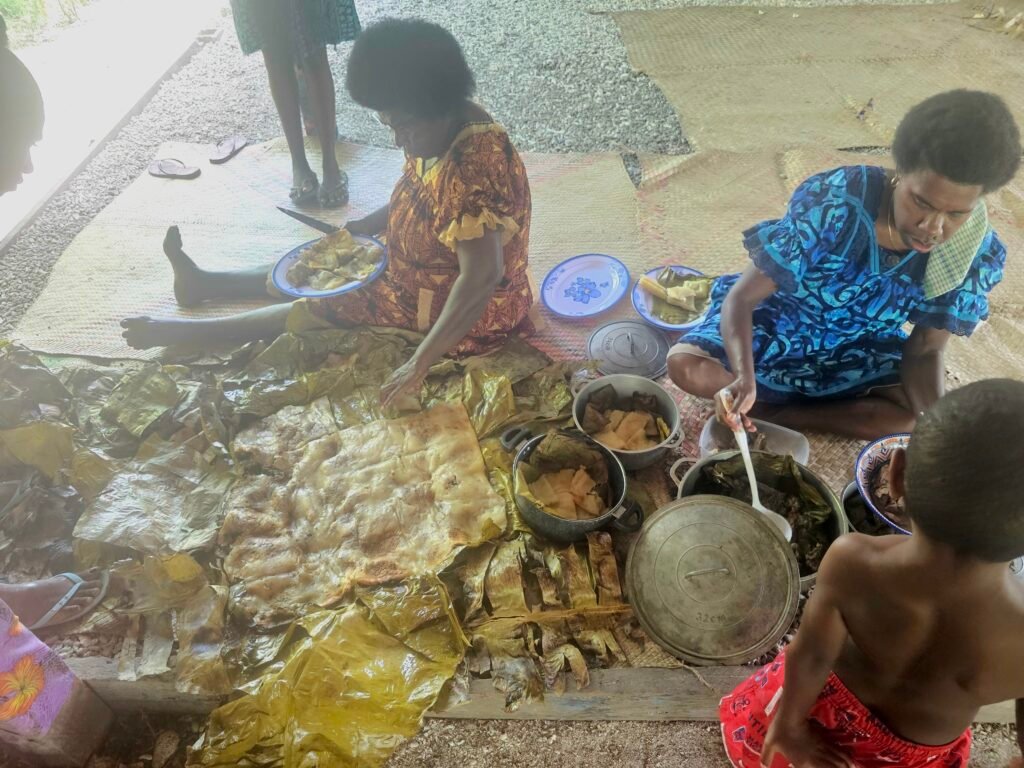
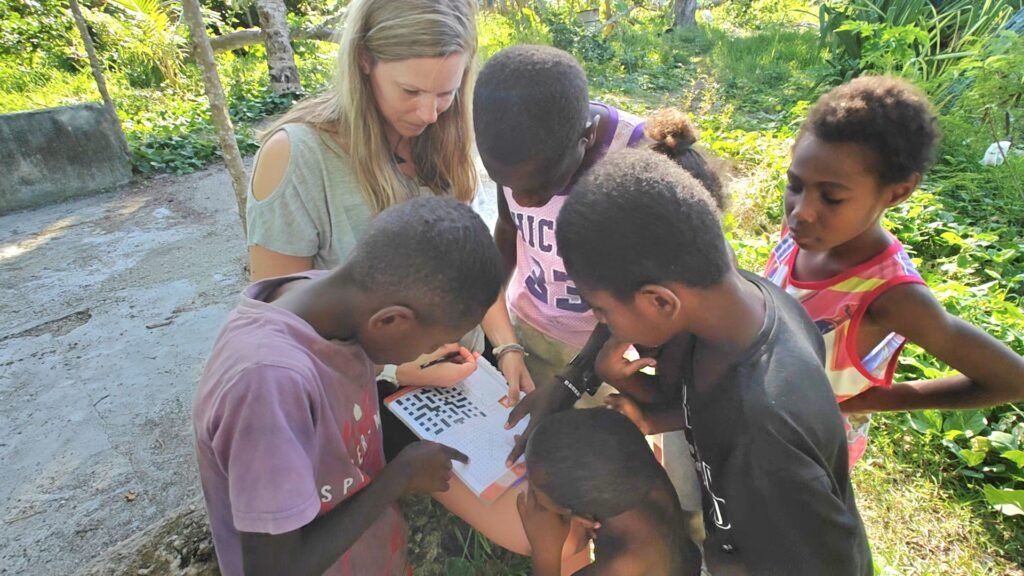
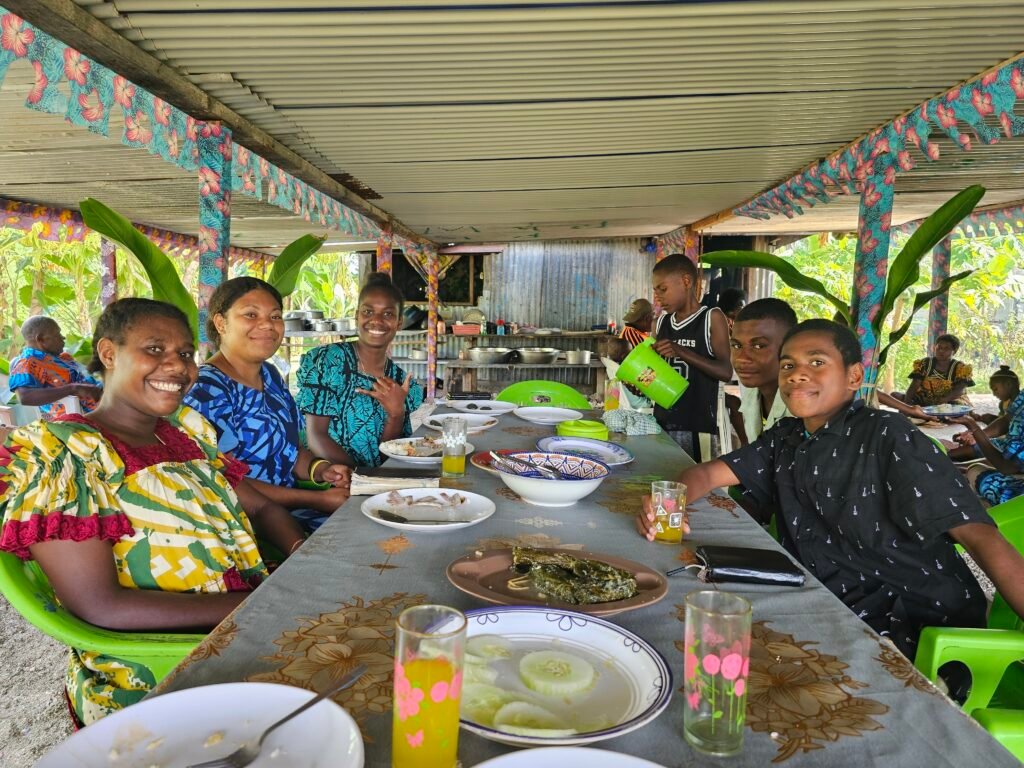
After we ate, little Rundron kept asking to play the “jumping” game, as I had shown him how to play hopscotch in the morning. So, we went back to the beach with around 20 other kids and played non-stop until we were exhausted. Of course, our exhaustion—those little play machines never get tired. The kids loved playing with my long blonde hair. At one point, I had to call it off when 10 kids at the same time were pulling on my hair. The kids also liked pushing my skin and seeing it go white before returning to its normal colour. Just fascinating how our differences were explored in detail—even pushing “my cute little nose” several times.
Amazing to see all the kids play outside—I had to dig deep into my memories to come up with games we used to play as kids before devices were a thing. My favourite part was probably playing in the mud, forming balls to play with. I used to love playing in the mud as a child and obviously still do. Once the Football was brought out, we got a break because everyone young or old is into Football here in Vanuatu. Amos absolutely loved my puzzle book and used it till late in the evening. I also managed to explain to Amos and his friend Matthew how to play Sudoku, and they got it straight away. I will certainly send some word search books up from New Zealand once I get a chance.
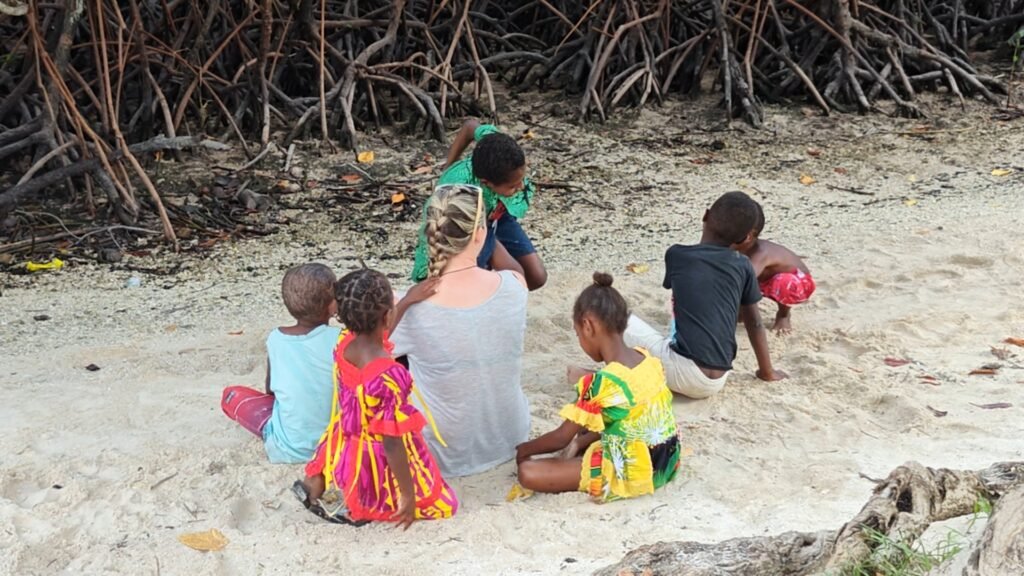
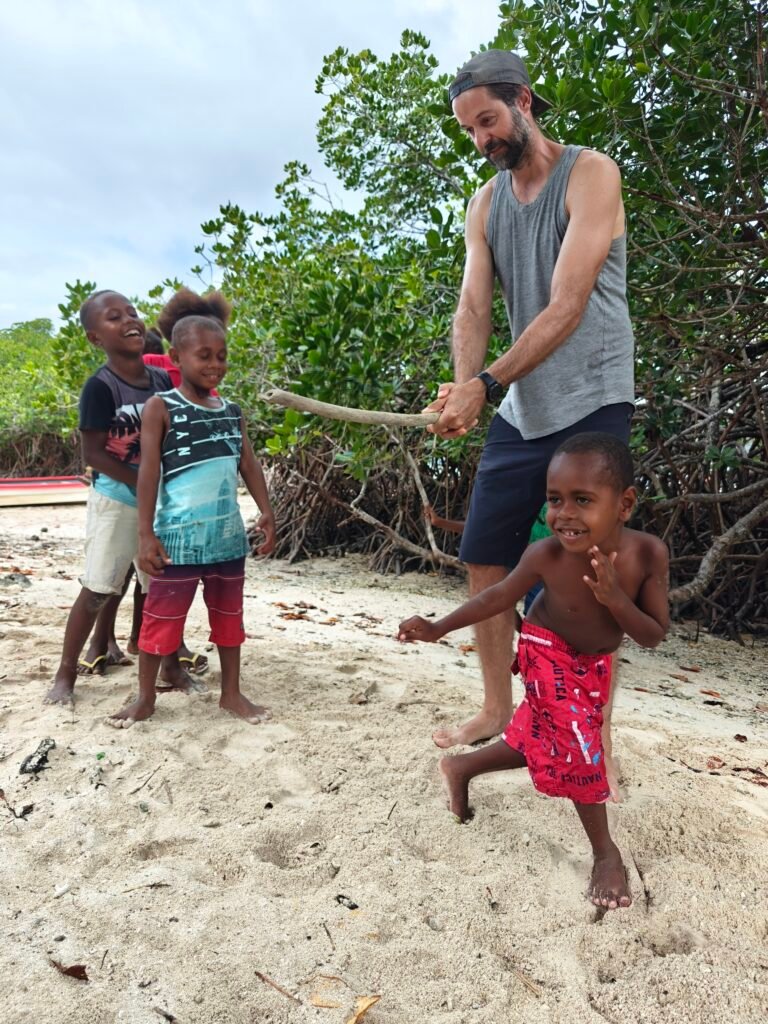
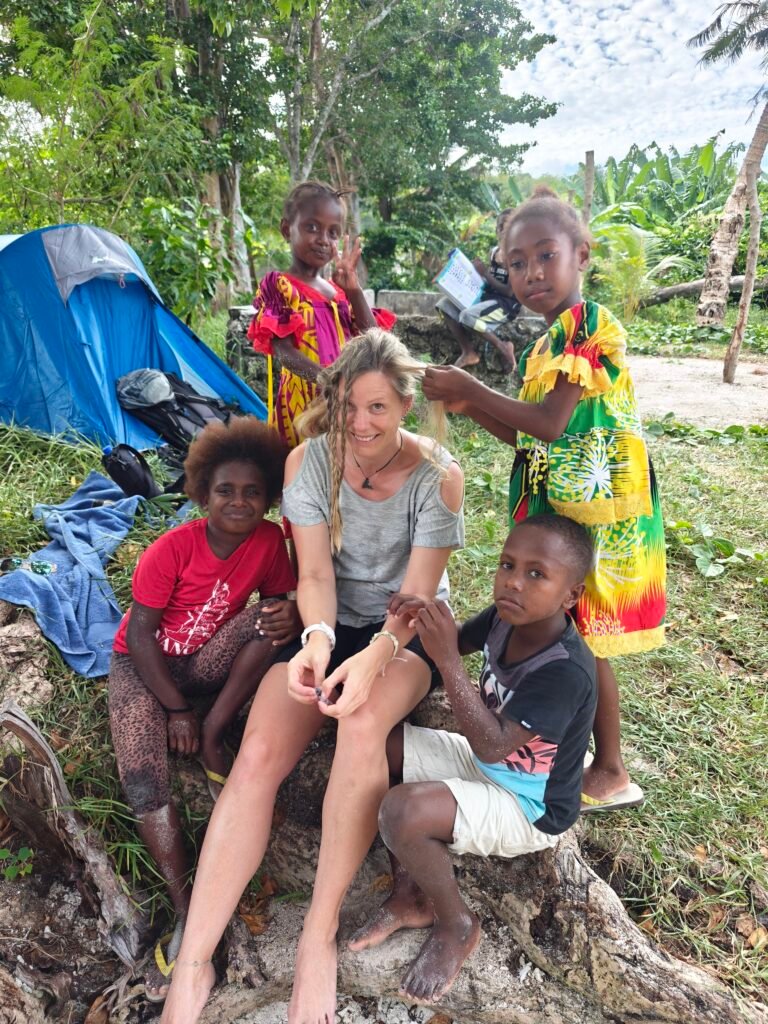
The next morning, we had breakfast with the kids and all the schoolchildren, who were waiting to be dropped off at school by boat by Owen, back to the other side at Efate. It was time to pack up for us, as I really wanted to go to Nguna to climb the extinct volcano. Owen and Jenny wanted to make sure we were looked after at Nguna and also wanted to ensure we got there safely, so they offered to drop us off after lunch. They had contacted their family in Nguna, where we could pitch our tent. After a last lunch and saying goodbye to everyone we finally headed off.
The trip to Nguna was very interesting. The reef between Moso and Efate, going north to Nguna, can only be crossed at high tide. We thought we might still be alright, but unfortunately, we got stuck with the boat and had to wait for the tide to rise. It was totally fine, as we got to chat with Jenny and Owen while waiting. Something wanted us to be there and have one last long chat before heading off. Once the tide came back, we managed to push the boat through the reef and carry on. It was pretty windy and bumpy, and I was worried for Owen and Jenny going back on their own.
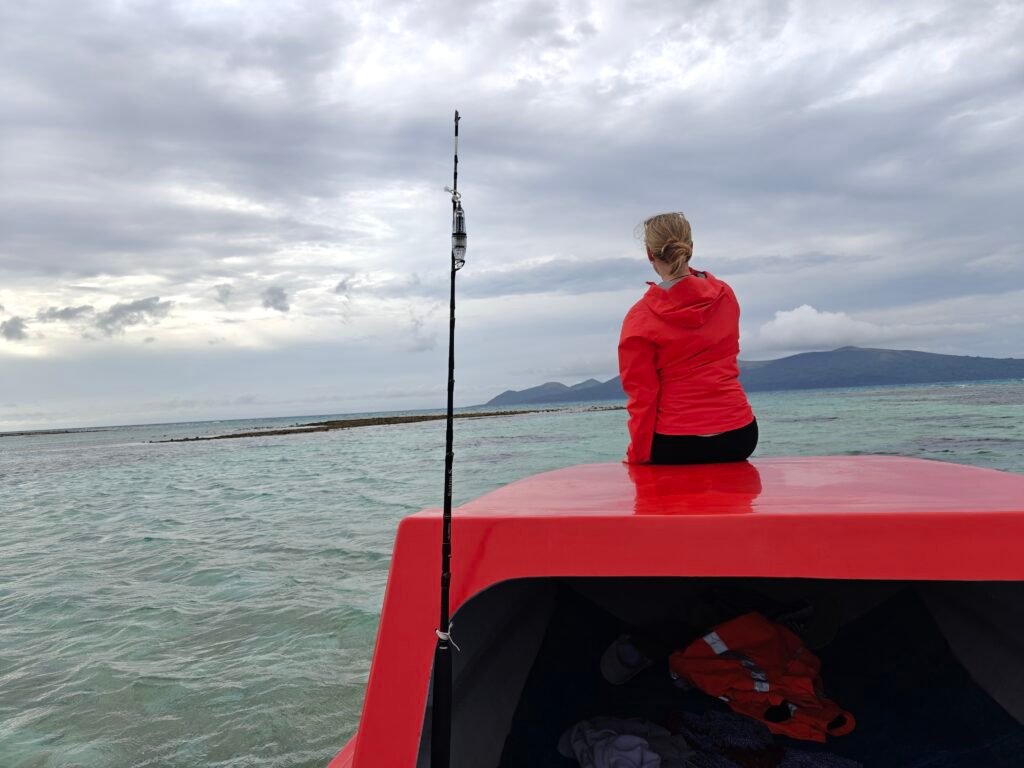
But once we got to Nguna, Owen organised for his family to pick us up from the boat and take us to their place. It was sad to say goodbye to Jenny and Owen, but Juanita, who greeted us on Nguna, was so lovely that I was looking forward to a new family adventure on Nguna. Thanks so much to everyone on Moso Island for taking us in like family and looking after us. We will be forever grateful for the experience and learned so much about Ni-Vanuatu culture. We think of you often and hope to meet again.

Awesome island hopping, and meeting happy people.
It was amazing and people in Vanuatu are beautiful 🙂